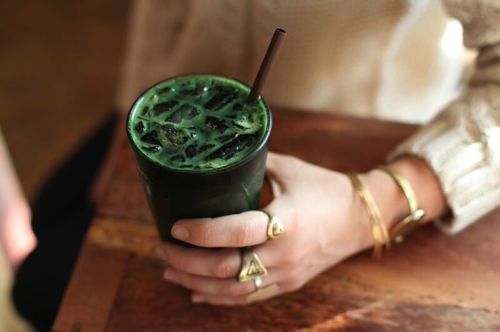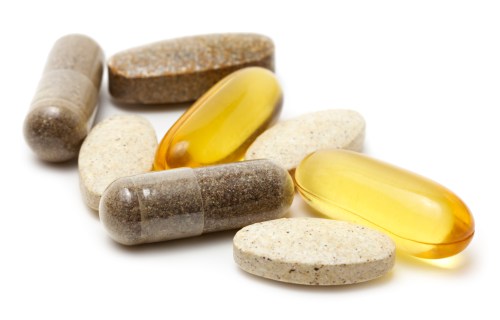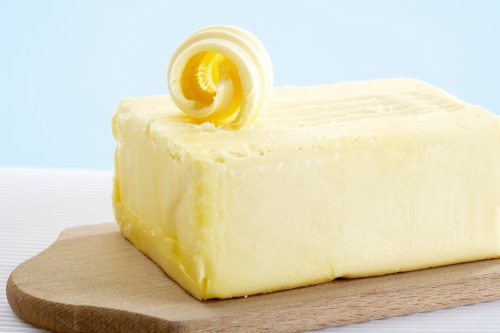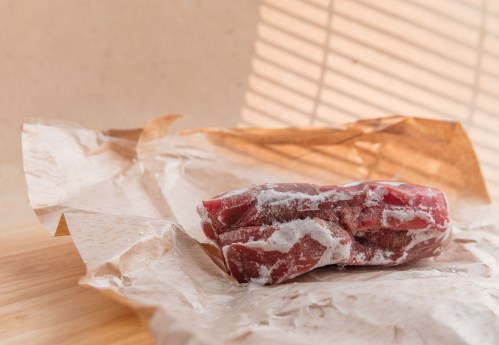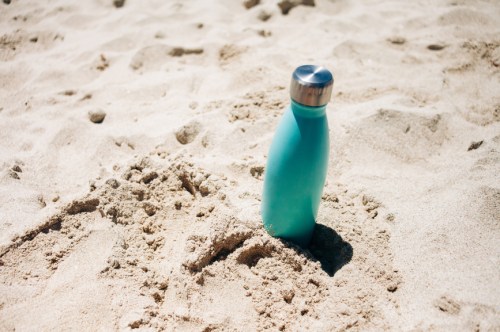Chlorophyll has long been an unsung hero of the superfood world—it’s not as sexy as maca or matcha, but if you open up any wellness-minded tastemaker’s pantry, you’ll most likely find a bottle of the green stuff inside.
To wit: Jennifer Lawrence adds liquid chlorophyll to her post-workout hydration; Hannah Bronfman considers it a secret weapon for her smoothies; and LEAF.tv co-founder Geri Hirsch puts a few drops of it in a glass of water to beat the 2 p.m. slump.
But lately, the plant-powered superfood is finding an even bigger place in the mainstream spotlight. No longer reserved for health-food stores, chlorophyll-infused waters and tonics are now popping up in ultra-cool restaurants, cocktail bars, beauty shops, and beyond.
The effect is similar to downing a green juice—but at about half the price.
Why is everyone suddenly getting turned on to chlorophyll’s charms? Well, for one thing, it’s a potent antioxidant with some seriously powerful detoxifying properties—and who wouldn’t be down with that? “Chlorophyll binds to harmful procarcinogen chemicals—toxins that turn into [cancer-promoting] carcinogens when metabolized—and inhibits them from being absorbed into the intestines,” says Carly Brawner, holistic nutritionist and health coach at Frolic and Flow.
Chlorophyll’s best known for its ability to flush heavy metals out of the body, but that’s not all. “Some of the most important procarcinogens that chlorophyll binds to are aflatoxin-B1, which is a mold found on many grains, nuts, and beans, and heterocyclic amine toxins caused by meat cooked at high temperatures,” says Brawner. As if that weren’t enough, it’s also been studied for the treatment of wounds and colon cancer.
And then there’s the fact that, in its liquid form, chlorophyll can be added to pretty much any beverage. “Chlorophyll doesn’t taste like much when mixed with other flavors, and it’s a beautiful shade of emerald green,” Brawner notes.
Healing power and good looks? No wonder it’s having a moment.
Read on to find out more about what chlorophyll is, where to find the new wave of chlorophyll-spiked drinks, and how to make one at home (it’s really easy).
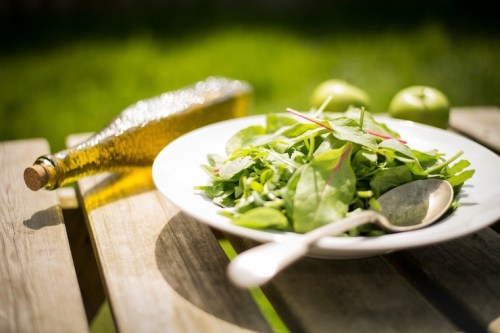
What is chlorophyll, anyway?
Think back to fourth grade bio and you’ll likely remember two things: chlorophyll gives plants their green hue and helps them turn light into energy.
So yes, any time you’re eating a green veggie, you’re getting a little hit of chlorophyll without even trying. “Foods with the richest sources of chlorophyll are spinach, parsley, watercress, and chlorella algae,” says Brawner. “It’s best absorbed in the body when eaten with some fat, and is most abundant in fresh, raw veggies.”
“I occasionally supplement with chlorophyll when I feel I need some cellular support, or want to rebalance after a night out or vacation.”
But unless you’re eating massive amounts of raw greens at every meal—Brawner notes chlorophyll levels in spinach decrease 50 percent when steamed or boiled—you’re likely not getting the same concentration of chlorophyll as you could in its supplemental form.
“I occasionally supplement with chlorophyll when I feel I need some extra cellular support, or want to rebalance after a night out or vacation,” says Brawner. Karen Pride, co-owner of healthy-cool cafe Harlow in Portland, Oregon, says the effect is similar to downing a green juice—but at about half the price. “I find [chlorophyll drinks] to be super energizing, detoxifying, and clarifying,” she says. “They’re a good hangover cure, too.”
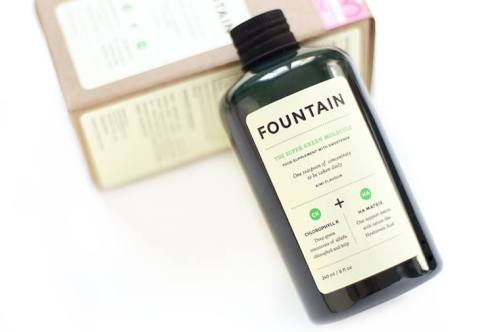
Chlorophyll branches out
Chlorophyll drinks may have juice-bar roots, but prepare to see them in a lot more places this year.
Harlow was an early adopter of the trend—its chlorophyll lemonade became a cult favorite at the restaurant when it debuted several years ago. “When we first put it on the menu, we had to do a lot of searching online to figure out where to buy the chlorophyll,” Pride recalls, adding that’s definitely not the case anymore.
The drink is made using local, organic lemon juice mixed with honey, cucumber-spinach-kale juice, and an ounce of liquid chlorophyll. (That’s about half a shot glass.) “I was talking to the GM of the restaurant about it and she calls it ‘sneaky greens,’ because it has all the benefits but you can’t really taste the greens,” she says. “Even kids like it.”
“Just as Gatorade brought the idea of the healthy function of electrolytes to the mainstream, our mission is to do the same with chlorophyll.”
Since then, she’s spotted chlorophyll drinks on lots of other menus—even internationally. “At a restaurant in Berlin this summer, I saw a server walking around with a dropper and adding it to people’s water,” she recalls.
Chlorophyll’s also making an appearance in beauty drinks, like The Super-Green Molecule by UK brand Fountain, and cocktails. (Dimes mixologist Arley Marks makes a mean chlorophyll shrub, while chlorophyll was one of the key ingredients in the Savila y Coca at LA’s ultra-hip Salazar last summer.)
And you’ll soon be seeing chlorophyll water at the grocery store, too, thanks to upstart brand Verday. “Each bottle of Verday chlorophyll water is packed with 100 milligrams of chlorophyll—more than you would find in 2 shots of wheatgrass, 4 cups of spinach, or 12 cups of arugula,” says Jonathan Murray, a company spokesperson. “Just as Gatorade brought the idea of the healthy function of electrolytes to the mainstream, our mission is to do the same with chlorophyll.” (Albeit, with no artificial colors or sweeteners and more refined flavors—think coconut, cucumber, and lemongrass ginger.)
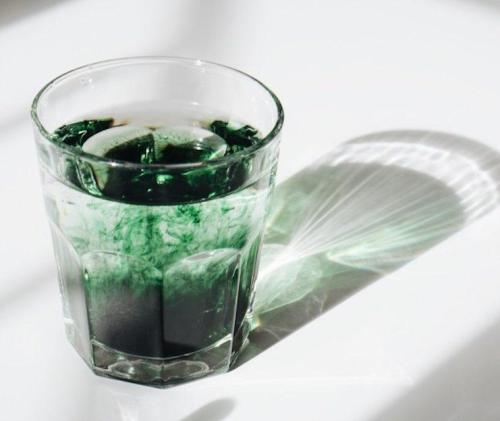
The DIY solution
Of course, it’s super easy (and affordable) to make your own chlorophyll beverage at home—just buy a bottle of liquid chlorophyll and add it to any drink. (If you’re taking a medication that makes you sun-sensitive, be sure to wear extra SPF—chlorophyll can enhance this side effect.)
“I mix together a glass of filtered water, a juicy squeeze of lemon, and a few drops of chlorophyll,” says Brawner. Pride prefers her chlorophyll water with fresh mint leaves and cucumber.
The best part: Unlike other homemade green drinks, there’s no need to clean a juicer or blender when you’re done. Talk about refreshing.
Chlorophyll’s not the only buzzy ingredient in the world of wellness beverages. Check out these inflammation-fighting winter sips, bloat-busting cocktails, and kick-ass kombuchas, all of which will do wonders for your gut health.
Sign Up for Our Daily Newsletter
Get all the latest in wellness, trends, food, fitness, beauty, and more delivered right to your inbox.
Got it, you've been added to our email list.
